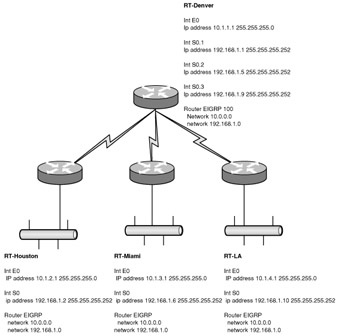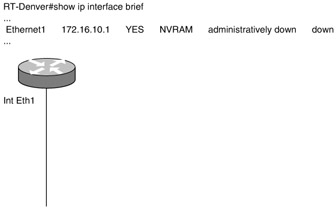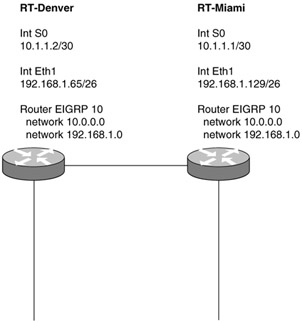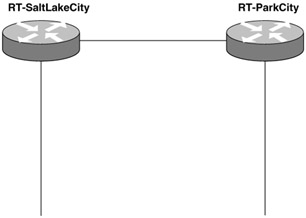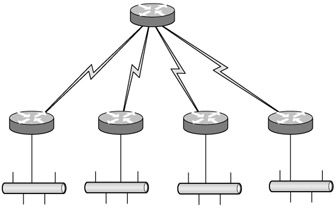CCNA-Practice Test 7
Directions: For each of the following questions, select the choice that best answers the question or completes the statement.
| 1. | When entering the following command, you receive an error. What is the problem?
access-list 110 permit ip any any eq 23
| |
| 2. | Suppose you are configuring a Frame Relay network, and Inverse ARP is not available. Which of the following must you configure to address this?
| |
| 3. | Look at the following diagram. Suppose you have configured IP addressing and routing as in the diagram. When you type the show cdp neighbor command on RT-Denver, you see all three remaining routers. However, when you type the show ip eigrp neighbor command, you do not see any of the other routers as EIGRP neighbors. Which of the following is the problem?
| |
| 4. | What is the signaling standard between the CPE device (usually a router) and the Frame Relay switch that is responsible for managing the connection and maintaining status between devices?
| |
| 5. | Which STP state prevents the use of looped paths?
| |
| 6. | When configuring a switch, what is the purpose of the ip address command?
| |
| 7. | What protocol is used to resolve a hardware address given the IP address?
| |
| 8. | Which of the following are valid reasons to use an access list? (Choose two.)
| |
| 9. | Which of the following is a valid extended IP access list?
| |
| 10. | When configuring OSPF on a Cisco router, the typical command looks something like this:
router ospf 1 What does the 1 represent?
| |
| 11. | You have been sent the output of a show ip interface brief command to diagnose a problem. Which of the following outputs indicate that there is an issue with layer 1?
| |
| 12. | Suppose you find the following static route added to a router. What does the 150 at the end of the command stand for?
ip route 172.16.10.0 255.255.255.0 172.16.20.1 150
| |
| 13. | Look at the following diagram. Suppose someone else has configured IP addressing and routing as in the figure. When you type the show cdp neighbor command on RT-Denver, you see all three remaining routers. However, when you type the show ip eigrp neighbor command, you do not see the RT-Houston router as an EIGRP neighbor. Which of the following is the problem?
| |
| 14. | Which one of the following are valid uses for an IP access list?
| |
| 15. | Which protocol is used to stop network loops in a switched internetwork?
| |
| 16. | When a switchport is set to mode access, what does that indicate?
| |
| 17. | You have been asked to configure a Cisco router that will have a point-to-point T1 connecting it to another brand of router. Which of the following is the best encapsulation choices for this T1?
| |
| 18. | Which command displays all the EIGRP feasible successor routes known to a router?
| |
| 19. | When will a source host receive an ICMP unreachable message?
| |
| 20. | Look at the following diagram. Suppose you need to trunk multiple VLANs between SW-Denver1 and SW-Denver2. Both switches are Cisco 2950s. Which is your option when configuring Fa1/1 on these switches?
| |
| 21. | Look at the following diagram You have been asked to troubleshoot this LAN. Hosts on VLAN 45 can communicate fine with each other but not with hosts on VLAN50. What is the problem?
| |
| 22. | You have been asked to create an access list that will deny the user at IP address 172.16.12.7 telnet access to the router. Which of the following lines can you use to accomplish this?
| |
| 23. | You have been asked to create an access list that will deny the user at IP address 172.16.12.7 telnet access to the router. Suppose you have created access-list 10 to do this. How and where do you apply the access list?
| |
| 24. | Look at the following diagram. You have been given a single Class C network and asked to subnet it for use on the four LANs shown. Assume that no LAN needs more than 60 addresses. Which subnet mask will efficiently use the addresses and meet this requirement?
| |
| 25. | You want the IP addresses, retransmit interface, and queue counts for adjacent EIGRP routers. What command displays this information?
| |
| 26. | Look at the following diagram. You have been told that users in Denver are no longer able to communicate with the network. You telnet into the RT-Denver router and issue the command shown. What is the problem?
| |
| 27. | Which of the following will you find in a routing table? (Choose three.)
| |
| 28. | Which one of the following commands are needed if you are running RIPv2 or EIGRP and have a discontiguous network?
| |
| 29. | You connect two switches together with a crossover cable. What will be the result?
| |
| 30. | Which layer of the OSI model is responsible for creating packets?
| |
| 31. | You have had a problem with users adding hubs at their desks and plugging in multiple devices. Which of the following switchport commands allows you to limit the number of MAC addresses on any port to 1 and disable the port if that number is exceeded?
| |
| 32. | Which of the following will become the RID of the router?
| |
| 33. | Suppose you have received the following output after typing in the show frame-relay map command. What does dynamic refer to?
Serial 0 (up): ip 10.1.1.1 dlci 1002 (0xB1,0x2C10), dynamic broadcast,...
| |
| 34. | How is the root bridge determined in a switched network?
| |
| 35. | Suppose a switchport LED is alternating between green and amber. What does this indicate?
| |
| 36. | Suppose a switchport status LED is solid amber. What does this indicate?
| |
| 37. | Look at the following diagram. You have configured the Denver and Miami routers as shown, yet the network has failed to converge. What do you suspect is the problem?
| |
| 38. | Look at the following diagram. The RT-SaltLakeCity router has already been configured. You need to add OSPF to the RT-ParkCity router and add network 10.0.0.0 into area 0. Which of the following commands should you use? (Choose two.)
| |
| 39. | You are trying to connect your PC to the console port of a Cisco router. How do you connect the host to the console port?
| |
| 40. | Look at the following diagram. You have configured the Boston router as shown in the figure. You need to add network statements to the RIP routing configuration. Which one of the following is the correct possible configuration?
| |
| 41. | Which configuration task must you complete if a remote Frame Relay router does not support Inverse ARP?
| |
| 42. | Look at the following diagram. HubA is plugged into port 1/15 of SwitchB. HubA has two hosts attached to it. How many MAC addresses would you expect to see on switchport 1.15?
| |
| 43. | You're given the following criterion when connecting access from a remote site to your LAN: "Restrict access on interface e0 for Telnet and FTP." Which of the following lines should come last when you configure your access list?
| |
| 44. | When configuring a switch, what is the purpose of the hostname command?
| |
| 45. | When VLANs have been implemented within a network infrastructure, what is required for inter-VLAN communication?
| |
| 46. | You have installed a new router into your network and have yet to configure access lists to filter traffic. You want to verify that routing has been successfully established and that end users will have no difficulty accessing applications across the network. Which of the following TCP/IP protocols can be used to test connectivity through all the layers of the OSI model?
| |
| 47. | You have a router running EIGRP, OSPF, and static routing. If a route to the 172.16.0.0/16 network is being learned by all three, which one will be used?
| |
| 48. | What is the default administrative distance for OSPF?
| |
| 49. | Regarding EIGRP, which of the following are true? (Choose two.)
| |
| 50. | Look at the following diagram. Assume that all hosts can communicate with each other. Which of the following statements must be true?
| |
| 51. | Look at the following diagram. Suppose someone else has configured IP addressing and routing as in the figure. When you type the show cdp neighbor command on RT-Denver, you see all three remaining routers. However, when you type the show ipeigrp neighbor command, you do not see the RT-LA router as an EIGRP neighbor. Which of the following is the problem?
| |
| 52. | Type the command to start IP RIP version 1 on a Cisco router.
| |
| 53. | _______________ are capable not only of dividing the collision domain into separate segments, but also of segmenting the broadcast domain.
| |
| 54. | Which of the following is true regarding the Cisco 2950 switch?
| |
| 55. | Look at the following diagram. You have a single Class C network address that is publicly registered. You need to address the network in the diagram. What is the most efficient subnet mask you can use to address the serial links?
| |
Answers
| 1. | B Explanation: B. An example of the correct usage when checking port values is access-list 110 permit tcp any any eq 23. |
| 2. | D Explanation: D. If Inverse ARP is not available, you must manually map the protocol addresses to the layer-2 addresses (DLCI). |
| 3. | A Explanation: A. In this case, the network statements for the 192.168 networks used on the serial links must be added to each of the routers' EIGRP configurations. |
| 4. | C Explanation: C. Local Management Interface (LMI) defines the signaling standard between your router and the Frame Relay switch and keeps track of virtual circuits. |
| 5. | A Explanation: A. A blocked port won't forward frames; it just listens to BPDUs. All ports are in blocking state by default when the switch is powered up. The purpose of the blocking state is to prevent the use of looped paths. |
| 6. | B Explanation: B. This command assigns an IP address to the switch, which is used to manage the switch. A switch does not need an IP address to work, but it needs one if you wish to telnet to it, for example. |
| 7. | D Explanation: D. Address Resolution Protocol (ARP) is used to find a hardware address from an IP address. |
| 8. | A, C Explanation: A, C. Access control lists can be used to limit access to services based on protocol and port information. Telnet access into a router is one specific service that can be limited with an access list. |
| 9. | C Explanation: C. The first option is wrong because you cannot filter by port number when specifying ICMP. The second option is wrong because it has the parameters in the wrong place. The last option is wrong because it specifies a standard access list. |
| 10. | C Explanation: C. The process ID is a number that starts the OSPF process on a router; it is locally significant to the router, meaning that it has no importance unless you start more than one process on the router, which is not typical. |
| 11. | C Explanation: C. Up/up indicates that layer 2 is down, up/down indicates that layer 1 is up but layer 2 is down, and down/down indicates a layer-1 problem. Administratively down indicates that the interface has been shut down. |
| 12. | C Explanation: C. The command ip route network subnet-mask next-hop-address administrative-distance is used to set a static route on that router. The administrative distance (AD) of a static route is normally 1, but you can increase it manually by entering a value at the end of the static route command. The command given in the question will set a static route to the network 172.16.10.0 by way of 172.16.20.1 (next hop) with an AD of 150. |
| 13. | C Explanation: C. In this case, everything else is correct. However, the serial connection between RT-Denver and RT-Houston is the first subnet in the 192.168.1.0 Class C network and thus the most likely cause. |
| 14. | E Explanation: E. Access control lists can do any of the things in the list. |
| 15. | B Explanation: B. Spanning-Tree Protocol (STP) is the protocol used in a layer-2 switched LAN to stop broadcast storms, multiple frame copies and other problems that can occur if a physical loop is accidentally connected into the network. |
| 16. | A Explanation: A. Access switchports connect hosts to a switch and are part of only one VLAN. |
| 17. | B Explanation: B. Frame Relay and ISDN encapsulations are not used on a p2p link. HDLC is proprietary to Cisco; therefore, PPP is the best choice. |
| 18. | C Explanation: C. EIGRP uses three different tables for routing: neighbor, topology, and route. The topology table keeps a list of every link found in the network. A feasible successor is a backup route stored in the topology table. |
| 19. | B Explanation: B. ICMP unreachable messages are returned when a service or host is not available. |
| 20. | C Explanation: C. The Cisco 2950 only supports 802.1q trunking. You cannot carry multiple VLANs on an access port. Etherchannel is used to bind multiple physical links into a single logical one. |
| 21. | B Explanation: B. Although switches can carry multiple VLANs, they cannot route between them. A router must be added to do this. |
| 22. | C Explanation: C. You can use the wildcard 0.0.0.0 to specify a specific host, or you can use the host parameter; however, the host parameter is used before the source IP address. |
| 23. | D Explanation: D. To control administrative access to the router, you apply the control to the VTY. In this case, an access list is referred to by the command access-class. |
| 24. | D Explanation: D. Using this mask will give you four subnets of 62 hosts each, assuming you have ip subnet zero enabled. |
| 25. | D Explanation: D. The show ip eigrp neighbors command shows a list of all routers with which the executing router has formed an adjacency. This command also provides the IP address of the neighbor routers and the retransmit and queue counts. |
| 26. | D Explanation: D. The administratively down status on the E0 interface indicates that it has been shut down. |
| 27. | A, B, C Explanation: A, B, C. Routing tables in a router keep track of where networks in a network are located, not hosts. They also keep track of the distance or cost to a remote network and which interface to exit to get to the remote network. |
| 28. | C Explanation: C. To support discontiguous networking, you first must have a routing protocol that is classless, such as RIPv2, EIGRP, or OSPF. OSPF supports discontiguous networks by default, but RIPv2 and EIGRP need to have the no auto-summary command enabled to support discontiguous networking. |
| 29. | D Explanation: D. To connect two switches together, you must have a crossover cable. The link lights will be green. |
| 30. | B Explanation: B. The Network layer of the OSI model is responsible for receiving segments or datagrams from the Transport layer of the OSI model. It encapsulates the segment or datagram by adding Network layer header information to create a Network layer packet. The Network layer is also responsible for receiving frames from the Data Link layer. It de-encapsulates the frame by stripping off Data Link layer protocol-encapsulation information to create Network layer packets. |
| 31. | A Explanation: A. This command will enable you to limit the maximum number of MAC addresses to 1. By default, the port will be disabled if this number is exceeded. |
| 32. | C Explanation: C. OSPF uses the highest physical-interface IP address configured on the router to choose the RID of the router. However, if loopback interfaces are created, and each has an IP address assigned, the highest IP address among the loopback interfaces is always the RID of the router. |
| 33. | D Explanation: D. In this case, dynamic refers to how the mapping was learned. The other option would be static. |
| 34. | C Explanation: C. Switches send Bridge Protocol Data Units out all interfaces every two seconds. The BPDU information includes the MAC addresses of the switches. If all switches have the default, or otherwise same, priority set, then the lowest MAC address of all the switches becomes the root bridge. |
| 35. | B Explanation: B. A switchport LED alternating between green and amber indicates that the switchport is experiencing excessive errors due to a link fault or another cause. If the port status is alternating green and amber, that indicates a link fault, or excessive errors. |
| 36. | A Explanation: A. When the port status is amber, it indicates that the switchport is not forwarding traffic (such as when STP puts a port in blocking state). |
| 37. | B Explanation: B. The two routers running EIGRP are, by default, both claiming to have the entire 192.168.1.0 Class C network. Disabling auto-summary will resolve this issue. |
| 38. | A, E Explanation: A, E. Proper configuration will place the area designation, along with correct network masking, in the network portion of the configuration. |
| 39. | B Explanation: B. Cisco console ports use a rolled cable to connect to a COM port of a PC. |
| 40. | A Explanation: A. Because RIP is a classful routing protocol, you only need to specify the 10.0.0.0 network. No mask is required. Selecting D and F would work, because the router would automatically change it to 10.0.0.0 in the configuration, but it is not the simplest way to configure the network statement. |
| 41. | A Explanation: A. Frame Relay can send an Inverse ARP packet to the device on the other side of the virtual circuit. If the other side does not support Inverse ARP, you must configure a static map. |
| 42. | B Explanation: B. You should see one for each host. |
| 43. | D Explanation: D. At the end of all access lists is an implicit deny all statement. Therefore, you must include a permit any any to allow traffic that does not meet your restrictions to continue. Also remember that 0.0.0.0 255.255.255.255 is the same parameter as "any." |
| 44. | A Explanation: A. This command is used to assign a name to the switch. If there is more than one switch, giving them distinct names greatly simplifies administration. |
| 45. | D Explanation: D. Devices in a VLAN are within their own broadcast domain and communicate freely among themselves. VLANs create network partitions, segmenting traffic at layer 2 of the OSI model. For inter-VLAN communication to occur, either a router, a layer 3 switch, or a route-switch module must be used. |
| 46. | A Explanation: A. Telnet is an Application layer protocol. Successfully telnetting between hosts confirms that connectivity at all layers is functioning properly. |
| 47. | C Explanation: C. By default, static routing has the lowest AD of any of the three listed routing methodologies. |
| 48. | D Explanation: D. OSPF's default administrative distance is 110. |
| 49. | A, B Explanation: A, B. EIGRP has a maximum hop count of 255 with a maximum hop count of 100 set by default. EIGRP can route multiple routed protocols, not just IP, and is considered a classless routing protocol, which means that networks can have different length subnet masks. EIGRP supports and can differentiate between internal and external routes. |
| 50. | B, E Explanation: B, E. For the host on VLAN20 to communicate with the host on VLAN 30, the router must be routing these two VLANs. Thus, the single physical interface on the router must be acting as multiple logical interfaces and therefore has multiple IP addresses. For this to work, the link between the router and switch must be a trunk link. |
| 51. | B Explanation: B. The IP addresses used on the serial link between RT-Denver and RT-LA are incorrect. They should be 192.168.1.9 and 192.168.1.10. |
| 52. | A Explanation: A. In global configuration mode, you enter router rip to start the routing process using the RIP protocol. Version 1 of RIP is the default. |
| 53. | D Explanation: D. Routers are the traditional workhorses of the corporate internetwork, segmenting both the broadcast and collision domains. Routers operate at layer 3 of the OSI model and provide substantially greater administrative control over the flow of information through a network than do devices operating at any of the lower layers. |
| 54. | A Explanation: A. The 2950 switch series only supports 802.1q trunk links. The typical number of VLANs configured on a 2950 switch is 64, but some models can support more. The administrative VLAN is VLAN 1 by default on all switches. |
| 55. | D Explanation: D. A /30 subnet mask allows two hosts per subnet, which is ideal for serial connections. |

